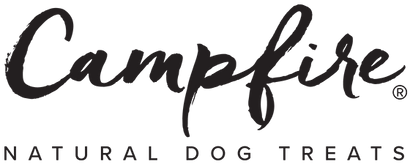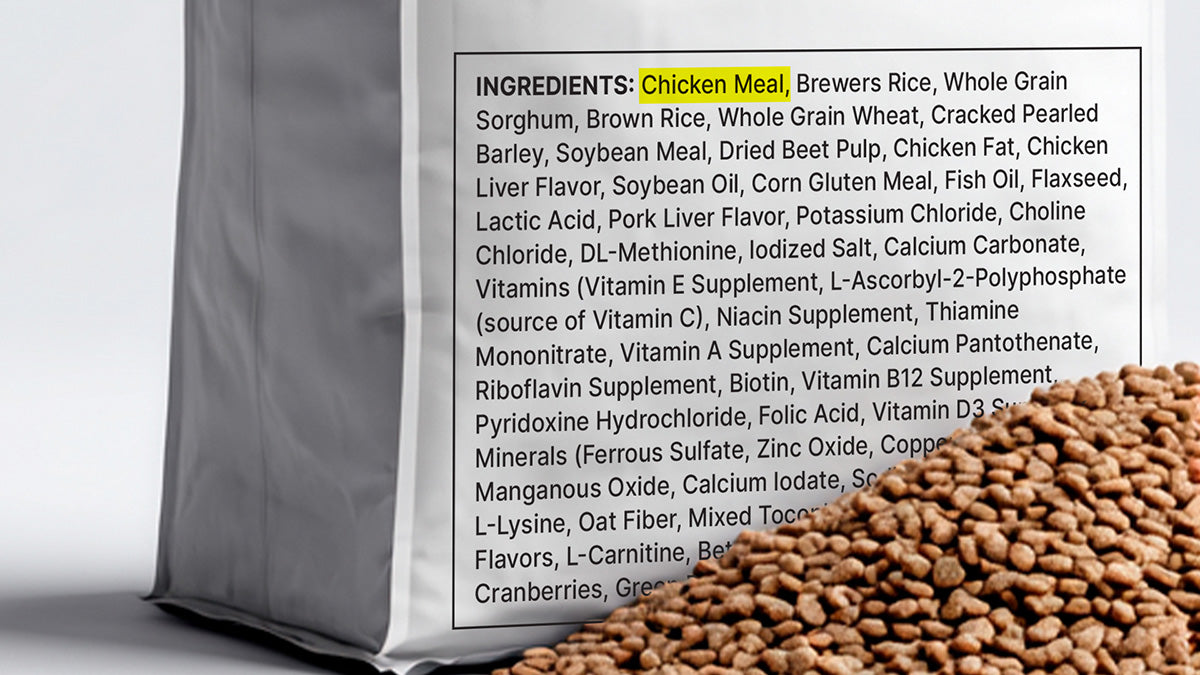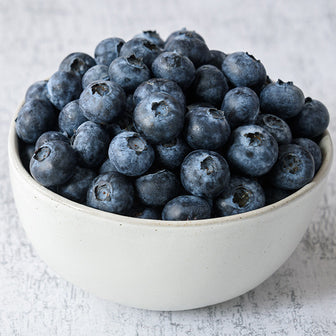Most pet owners have seen “chicken meal” listed as an ingredient on the packaging of their dog’s food, but many don’t know what it actually means. In this article, we’ll explore what chicken meal is, how it’s made, why it’s used in pet food, and whether it is a healthy and nutritious ingredient choice. We’ll also look at other types of “meals” in pet food and discuss the nutritional and ethical concerns around them.
Chicken meal in dog food
Chicken meal is the most common animal-derived ingredients in dog food. According to the Association of American Feed Control Officials (AAFCO), it is a high-protein powder made from chicken flesh and skin, with or without bone, but excluding feathers, heads, feet, and entrails.

Poultry Meal (Source: JGP Low Ash Poultry Meal)
Chicken meal is produced by what the pet food industry refers to as rendering. During the rendering process, heat and pressure remove most of the water and fat, leaving mainly protein and minerals behind. The high temperature of the process also eliminates potentially present foodborne pathogens, such as Salmonella and E. coli. The term “meal” is used because, in addition to cooking, the material is ground into a fine powder during the final step.
Is chicken meal the same as chicken?
Some pet foods list both chicken and chicken meal as ingredients. At first, this may look like a labeling mistake, but it isn’t. You can safely assume the label is correct.
While both come from chicken, they are not the same ingredient, and their nutritional profiles differ significantly.


Chicken and chicken meal in dog food (Source: Blue Buffalo® Life Protection Formula™ Chicken and Brown Rice Recipe)
Chicken, as an ingredient in pet food, must be made from fresh chicken. If prepared gently and at low temperatures, the chicken will contain most of the amino-acids, fatty acids, minerals, and vitamins found in fresh chicken meat.
Chicken meal, by contrast, is made from a mix of flesh, skin, connective tissue, and sometimes bone, processed at temperatures around 280°F. The final product is a protein powder containing around 15% residual fat, which is rich in minerals, but deprived of most vitamins. Research by Dr. Greg Aldrich of Kansas State University further suggests that the protein and fat in chicken meal not only vary in quality but are also of reduced nutritional value compared to fresh or low-temperature air-dried chicken. He further points out that chicken meal can make up 5-40% of a typical pet food formula and may supply more than 80% of the protein and around 30% of the fat. Because it represents such a large share of the diet, even small changes in the quality or composition of chicken meal can have a major impact on the nutrition pets receive.
Why is chicken meal such a popular ingredient for pet food?
Chicken meal has become the protein source of choice for high-volume, lower-quality pet foods like kibble, because of three main reasons:
- Dogs need a lot of protein as part of their diet: According to the AAFCO the diet of a growing dog should contain at least 22.5% protein on a dry matter basis and a minimum of 18% for adult dogs.
- Availability: To feed the almost 90 million dogs living in the United States, the pet food industry requires enormous amounts of animal protein every year. Chicken is the most popular meat consumed in America. In the US alone, more than 9.4 billion chickens are raised for meat annually. This leaves vast amounts of co-products or by-products (such as residual flesh, connective tissue, bones, undeveloped eggs, etc.), which are available as inexpensive ingredients for various types of chicken meals.
- Cost-effectiveness: Is chicken meal a high-quality ingredient for pet food? No — but it perfectly meets the requirements of the pet food industry as it is low in cost, can be stored without refrigeration, and has a long shelf life.
Are there other “meals” aside from chicken meal?
Yes, a broad range of animal-derived “meals” are used as ingredients in pet food. They differ in protein source, composition, quality, and price. The main categories of animal meals are the following:
- Meat meal: A powder made from rendered mammal tissue without bone. It cannot contain added blood, hair, hooves, horns, hide trimmings, manure, stomach, or rumen contents. Unlike meat and “meat by-products,” meat meal may come from mammals other than cattle, pigs, sheep, or goats without further description. If a specific species is stated, the meal must only contain this species. Beef meal, for example, must contain only cattle and no parts of any other species.
- Meat and bone meal: A powder made from rendered animal tissue originating from mammals, including bone, but exclusive of added blood, hair, hooves, horns, hide trimmings, manure, stomach, and rumen contents. If a specific species is stated, the meal must contain only that species (e.g. goat meat and bone meal may contain only goat).
- Animal by-product meal: A powder made from rendered animal tissue originating from mammals, often with more by-products that would normally be found in meat meal or meat and bone meal.
- Poultry meal: A powder made from rendered clean flesh and skin, with or without bone, derived from whole carcasses or parts of poultry, or a combination thereof. It excludes feathers, heads, feet, and entrails. If a specific species is stated, the meal must only contain this species (e.g. chicken meal may contain only chicken).
- Poultry by-product meal: A powder consisting of the ground, rendered, clean parts of the carcass of slaughtered poultry, such as necks, feet, undeveloped eggs, and intestines, but not feathers. If a specific species is stated, the meal must only contain this species (e.g. turkey by-product meal may contain only turkey).
- Fish meal: The clean, dried, ground, undecomposed tissue of whole fish or fish cuttings, either or both, with or without oil extraction. If a specific species is stated, the meal must only contain this species (e.g. salmon meal may contain only salmon).
- Other animal-derived meals: Made from animals other than mammals, poultry, or fish. Examples include black soldier fly larvae meal, crab meal, mealworm meal, and shrimp meal.
In addition to animal-derived meals, various plant-based meals, including corn gluten meal or soybean meal, are also permitted pet food ingredients.
The Association of American Feed Control Officials provides the official definitions for each of these meals, ensuring consistency in labeling across the pet food industry.
Are non-slaughtered animals permitted as ingredients in chicken meal?
Yes. Contrary to the expectations of most pet parents, carrion meat and tissue from animals that have died by means other than slaughter — also referred to as 4D meat (dead, dying, disabled, or diseased) — are allowed as ingredients in various meals, including chicken meal, and consequently in pet food.
“If FDA and AAFCO standards and guidelines are followed, dead, dying, disabled, or diseased animals are permitted as ingredients in pet food.”
The Food and Drug Administration (FDA) stated in response to a citizen petition issued by Susan Thrixton of the Association for Truth in Pet Food “…we do not believe that the use of diseased animals or animals that died otherwise than by slaughter to make animal food poses a safety concern…” and continued “…we [therefore] deny your request that we work with [the] AAFCO to modify the ingredient definitions to include the requirement that the ingredients be "derived from a slaughtered animal".
The AAFCO states: “Meat and meat byproducts from animals that have died by other means than slaughter aren’t directly suitable for animal food because these products are considered adulterated. They can’t be used for animal feed unless they contain no chemical additives and are heat-treated and further processed. For dry kibble and canned pet foods, the final product should be free of disease-causing bacteria.”
This means, if FDA and AAFCO standards and guidelines are followed, dead, dying, disabled, or diseased animals are permitted as ingredients in pet food.
Why are non-slaughtered animal parts as pet food ingredients problematic?
The use of 4D animal parts and tissue in pet food is problematic in three ways:
- Low nutritional value: While rendered meals containing 4D animals are considered safe pet food ingredients by the AAFCO and FDA, they represent the lowest quality within an ingredient category that already has limited nutritional value.
- Potential to bypass animal welfare laws and regulations: The United States Department of Agriculture’s Food Safety and Inspection Service is responsible for verifying that all federally inspected livestock establishments comply with the Humane Methods of Slaughter Act. This act applies only to the slaughter of animals. Animals that die by other means are not protected. The use of 4D animals therefore opens the possibility of bypassing existing animal welfare laws and regulations and may expose animals to otherwise prohibited cruelty.
- No labeling requirements: Pet food manufacturers are not required to disclose if 4D ingredients are used in a product. If not voluntarily declared by a manufacturer, it is impossible to know whether pet food containing meals also contains material from non-slaughtered animals. Since most pet parents are unaware that dead, dying, diseased, or disabled animals may be used in pet food, this practice raises significant ethical concerns.
Here’s what pet parents should remember
Chicken meal is a common, affordable, and protein-rich ingredient in dog food, but its quality can vary widely. While chicken meal is generally considered a safe protein source, concerns about quality and ethics remain — especially when 4D meat is involved. Choosing brands that are open about sourcing and processing is the best way to make sure your dog is getting safe, consistent, and nutritious food.














